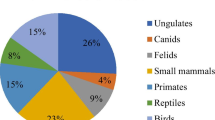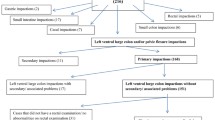Abstract
A prospective study was conducted to describe clinical epidemiology of equine colic in the Society for Protection of Animal Abroad and Donkey Sanctuary Project Clinic, at Debre Zeit, Ethiopia, from November 2014 to April 2015. The objectives were to describe clinical epidemiology of equine colic, to characterize the main types of equine colic, and to determine the major risk factors associated with equine colic. The method which was used in the study was attending clinical case of equine and assessing physiological parameters, fecal egg count, abdominal sounds, and rectal examination as well as questioner interviewing of the owners. The data were collected and analyzed using Statistical Package for Social Science. The incidence of colic was 10.3% in the study period. Colicky were typed as unknown, flatulent, impaction, spasmodic, and enterolithiasis. The proportion of case incidence were 63.1 (41/65), 33.8 (22/65), and 3.1% (2/65), in donkey, horse, and mule, respectively. The total mean (±SD) of temperature 37.80 ± 1.003, heart rate 57.54 ± 10.098, fecal egg count 236.922 ± 67.990, respiratory rate 30.92 ± 7.315, and packed cell volume 41.40 ± 10.221 were recorded. The case fatality rate of equine colic was 15.38% (10/65). There were statistically highly significant (p < 0.01) differences in impaction colic in relation to species. Interview with 183 equine owners revealed incidence of equine colic as the sixth major disease condition affecting equine. A long-term epidemiological study of the true representative population should be carried out to determine the incidence rate and associated risk factors of equine colic in the study area.
Similar content being viewed by others
References
Archer, D. and Proudman, C., 2006. Epidemiological clues to preventing colic. Vet. J. 172:29–39.
Archer, D., Pinchbeck, G., French, N. and Proudman, C., 2008. Risk factors for epiploic foramen entrapment colic in a UK horse population: a prospective case-control study. Equine Vet. J. 40: 405–410.
Ayele, G., Feseha, G., Bojia, E., Getachew, M., Alemayehu, F., Tesfaye, M., Amare B., Dereje N., Chala, C., Asefa, A., Anzuino, J. and Trawford, A., 2006. Sarcoids: clinical epidemiology, principal effects and treatment responses. 5th International Colloquium on Working Equines. Ethiopia, Addis Ababa.
Bojia, E., Feseha, G., Alemayehu, F., Ayele, G., Tesfaye, M., Trawford A. and Anzuino, J., 2006. A comprehensive approach to minimize the fatal effects of tetanus and colic in donkeys of Ethiopia. The 5th international Colliqium on Working Equines. Ethiopia, Addis Ababa.
Braun, U., Schoberl, M., Bracher, V., Geyer, H. and Feige, K., 2002. Prognostic factors in equine colic. 571:15–22.
Claude, A., Dennis, R., Meagher, M., Schrader, J. and Honnas, C., 2008. Abdominal auscultation in the detection of experimentally induced gastrointestinal sand accumulation. J. Vet. Int. Med. Volume (3), Issue 1, Article first published online: 28 Jun 2008.
Cohen, N., 2003. The John Hickman Memorial Lecture: colic by numbers. Equine Vet. J. 35:343–349.
Cohen, N., Vontur, C. and Rakestraw, P., 2000. Risk factors for enterolithiasis among horses in Texas. J. Am. Vet. Med. Ass. 216:1787–1794.
Coles, E.H., 1986. Veterinary clinical pathology. 4th ed., Saunders, W.B. Company, Philadelphia. 110–115.
Cox R., Proudman J., Trawford F., Burden F. and Pinchbeck L. (2007). Epidemiology of impaction colic in donkeys in the UK. Sidmouth, UK. BMC Vet. Res. 3(1):1–11
Cox, R., Burden, F., Gosden, L., Proudman, C., Trawford, A. and Pinchbeck, G., 2009. Case control study to investigate risk factors for impaction colic in donkeys in the UK. Prev. Vet. Med. 92:179–187.
Duffield, H., Bell, N. and Hensen, F., 2002. The Seventh International Equine Colic Research Symposium Handbook. 122.
Egenvall, A., Penell, J., Bonnett, B., Olson, P. and Pringle, J., 2006. Mortality of Swedish horses with complete life insurance between 1997 and 2000: variations with sex, age, breed and diagnosis. Vet. Rec. 158:397–406.
Ehrhardt, E. and Lowe, J., 1990. Observer variation in equine abdominal auscultation. Equine Vet. J. 22(3):182–185.
Goncalves, S., Julliand, V., and Leblonde, A., 2002. Risk factors associated with colic in horses. Vet. Res. 33:641–652.
Hart, S. and Southwood, L., 2010. The enigma of post operative recurrent colic: challenges with diagnosis and management. Equine Vet. J. 22:408–411.
Hillyer, M., Taylor, F. and French, N. (2001). A cross-sectional study of colic in horses on thoroughbred training premises in the British Isles in 1997. Equine Vet. J. 33:380–385.
Hillyer, M., Taylor, F., Proudman, C., Edwards, G., Smith, J. and French, N., 2002. Case control study to identify risk factors for simple colonic obstruction and distension colic in horses. Equine Vet. J. 34(5):455–463.
Hudson, J., Cohen, N., Gibbs, P. and Thompson, J. 2001. Feeding practices associated with colic in horses. J. Am. Vet. Med. Assoc. 219(10):1419–1425.
Kaya, G., Sommerfeld-Stur, I. and Iben, C., 2009. Risk factors of colic in horses in Austria. J. Anim. Physiol. and Anim. Nutri. 93(3):339–349.
Laranjeira, P., de Almeida, F., Pereira, M., Lopes, M., de Campos, C., Cajuby, L. and de Souza, P., 2009. Profile and distribution of equine colic syndrome in three military units in Rio de Janeiro, Brazil. Cienc. Rural, (39), 1116–1123.
Mair, T., 2004. BEVA evidence-based medicine colic survey. In: Proceedings British Equine Vet. Assoc. congress. Birmingham, UK. 58–59.
Mair, T. and Smith, L., 2005. Survival and complicationn rates of 300 horses undergoing surgical treatment of colic. Part 1: Short-term survival following a single laparotomy. Equine Vet. J. 37:296–302.
Mehdi, S. and Mohanvmad, V., 2006. A farm-based prospective study of equine colic incidence and associated risk factors. J. Equine Vet. Sci. 26 (4):171–174.
Mellor, D., Love, S., Walker, R., Gettinby, G. and Reid, S.W.J., 2001. Sentinel practise-based survey of the management and health of horses in northern Britain. Vet. Rec. (149), 417–423.
Mueller, P. and Moore, J. 2000. Rectal examination of horses with acute abdominal pain. Comp. Cont. Educ. for the Practicing Veterinarian. 6:606–615.
Pearson, R. and Ouassat, M. 2000. A guide to live weight estimation and body condition scoring of donkeys. Centre for Trop. Vet. Med. Edinburgh.
Pilliner and Davies, 2004 Pilliner S. and Davies Z. 2004. Equine Science, 2nd Ed. Blackwell Publishing. Oxford, UK.
Plummer, A. 2009. Impactions of the small and large intestines. Vet. Clin. Equine, 25:317–27.
Proudman, C. and Holdstock, N., 2000. Investigation of the outbreak of tapeworms associated colic. Equine Vet. J. 32:37–41.
Proudman, C., Smith, J., Edwards, G. and French, N. 2002. Long-term survival of equine surgical colic cases. Part 1: Patterns of mortality and morbidity. Equine Vet. J. 34:432–437.
Radositis, O., Gay, C., Hichcliff, K. and Constable P, 2009. Veterinary medicine: a textbook of the diseases of cattle, horses, sheep, pigs and goats, 10th Ed. Sounders Elsevier, USA, MO. St. Luis. 188-199, 215–229.
Soulsby, E. 1982. Helminth, arthropod and protozoa of domestic animals, 7th Ed., London, UK. 809.
Southwood, L. and Fehr, J., 2013. Abdominal palpation per rectum. Practical guide to equine colic 1st Ed. New York. 22–37.
Southwood, L., Gassert, T. and Lindborg, S., 2008. Survival and complications rates in geriatric horses with colic, Proceedings 9th International Equine Colic Research Symposium. 87–88.
Thoefner, M., Ersboll, A. and Hesselholt, M., 2000. Prognostic indicators in the Danish hospital-based population of colic horses. Equine Vet, J. 32:11–18.
Thrusfield, M. 2005. Veterinary Epidemiology 3rd Ed. Black well science. UK, Oxfored. 183.
Traub-Dargatz, J., Kopral, C., Seitzinger, A., Garber, L., Forde, K. and White, N. 2001. Estimate of the national incidence of and operation-level risk factors for colic among horses in the United States, spring 1998 to spring 1999. J. Am. Vet. Med. Assoc. 219:67–71.
USDA, 2005. Available at: <http://www.usda.gov/wps/porta/usdahome>. Accessed December 2008.
White, N. 1990. Epidemiology and etiology of colic. In: White NA, editor. The equine acute abdomen. Philadelphia: Lea and Febiger. 50–64.
Yoseph, S., Feseha G. and Abebe, W. 2001. Survey of helminthosis of equines in Wonchi, Ethiopia. J. Ethiopian Vet. Assoc. 5: 47–61.
Acknowledgments
The authors would like to thank the Wollega University, School of Veterinary Medicine for financial and material support. The authors would also like to thank the SPANA and DHWP in the college of Veterinary Medicine and Agriculture in Addis Ababa University at Debre Zeit, Ethiopia, for the support, finance, and permission for doing the research.
Author information
Authors and Affiliations
Corresponding author
Ethics declarations
Conflict of interest
The authors declare that they have no conflict of interest.
Rights and permissions
About this article
Cite this article
Worku, Y., Wondimagegn, W., Aklilu, N. et al. Equine colic: clinical epidemiology and associated risk factors in and around Debre Zeit. Trop Anim Health Prod 49, 959–965 (2017). https://doi.org/10.1007/s11250-017-1283-y
Received:
Accepted:
Published:
Issue Date:
DOI: https://doi.org/10.1007/s11250-017-1283-y




